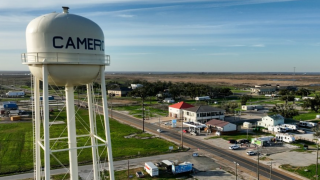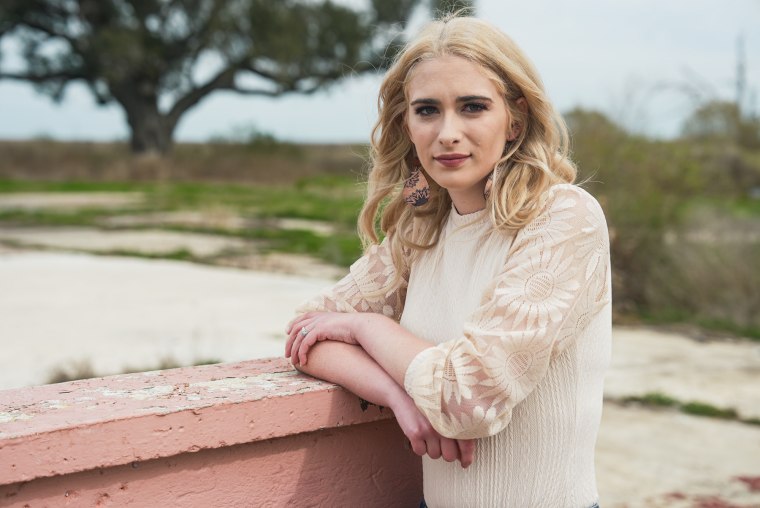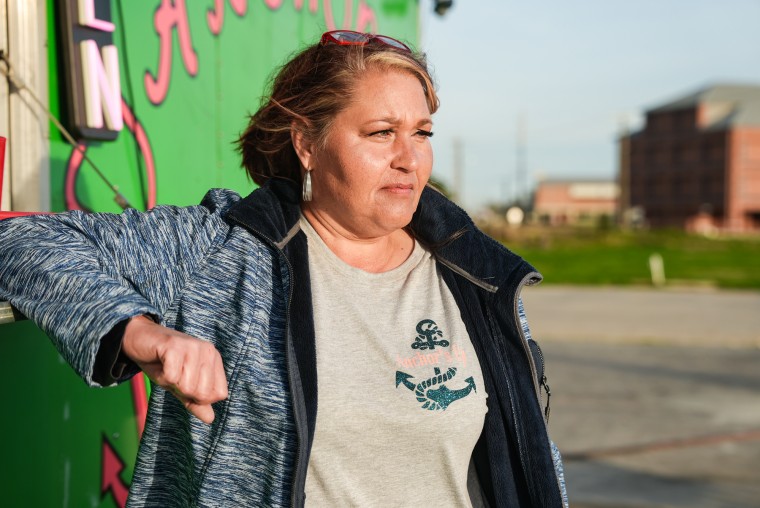
Seven days a week, Tressie LaBove Smith makes the two-hour round trip from Lake Charles to what’s left of her Cajun restaurant in Cameron, Louisiana, an unincorporated town perched along the stormy Gulf Coast. Business once boomed at Anchors Up Grill, which opened in 2014 as Cameron's only sit-down restaurant, NBC News reports.
In 2020, Hurricane Laura destroyed the restaurant along with most of the town. Smith now dishes out Louisiana home cooking from a food trailer to customers dining in a makeshift seating area dotted with a few plastic tables and chairs.
“There’s been times that I’ve thought, ‘Why am I doing this?’” Smith said. “I’ve been open for 10 years, and this is the toughest time I’ve ever had with my business.”
Cameron and the surrounding area have been devastated by a series of powerful hurricanes: Rita in 2005, Ike in 2008 and Laura and Delta in 2020. Some residents in Cameron have lost and rebuilt their homes four times over.
We've got the news you need to know to start your day. Sign up for the First & 4Most morning newsletter — delivered to your inbox daily. Sign up here.
These days, the locals call Cameron a ghost town.
Fewer than 200 people remain in what was once a bustling community with almost 2,000 residents. Before the storms, there were grocery stores, hardware shops, several restaurants and bars, and a functioning hospital.
U.S. & World
The day's top national and international news.
Now, Anchors Up Grill and a gas station mart provide the only food for purchase in Cameron. Locals buy their groceries in bulk once a week from Lake Charles, and a medical emergency could mean a death sentence, with the nearest hospital located 1 hour away.
Cameron Parish, which encompasses the town of Cameron, has lost more than half of its population. The storms have left the region with millions of dollars in damages and little capacity to rebuild. Some in the community say that the hurricanes are getting stronger and that climate change is to blame.
“We didn’t have a hurricane for 50 years, and then all of a sudden we had two in the last 15 years that wiped us out completely,” Smith said. “And they’re not little storms. They’re bad.”
In the last few decades, experts have observed an uptick in rapidly intensifying hurricanes, powerful storms that strengthen faster than ever before. Rising sea surface temperatures caused by global warming are fueling this trend, and in 2023 global ocean temperatures reached record highs. Scientists monitoring ocean temperatures at NASA declared last year that “the ocean has a fever.”

What hope there is for the area comes from a massive natural gas industrial complex just outside of town. The plant, operated by Virginia-based natural gas company Venture Global LNG, provides the few local jobs available in Cameron. And a proposal for an expansion could help boost industry in town.
But the project, which is pending federal approval, has been met with a wave of protests from climate activists who are pushing to end new fossil fuel projects. They call the project a “carbon bomb” for its future greenhouse gas emissions, which would contribute to global warming. At the end of January, the Biden administration announced a temporary pause on its decision regarding the terminal.
Despite its carbon footprint, many in Cameron support the proposal, including Sheriff Ron Johnson, who has served the community for over three decades. Johnson, like many in the parish, was born and raised in Cameron and has roots in town going back generations.
Johnson said he doesn’t believe in human-caused climate change, but he does believe that the storms have gotten stronger and more destructive over the years. The proposed export terminal could help revive Cameron’s economy, he said.
“We grew up with pipelines in our backyard,” Johnson said. “The oil and gas industry was part of us. The project will be very good for the nation, very good for Louisiana, and very good for Cameron Parish.”
The ghosts of Cameron
Cameron is eerily quiet. Driving through, the landscape is dominated by blank concrete slabs where the hurricanes have ripped dozens of structures from their foundations. Some neighborhoods are completely empty, apart from the spindly wooden legs meant to elevate homes away from floodwaters — the houses are long gone, but the legs still stand.
In other places, it looks like Hurricane Laura happened yesterday. A broken sign welcomes churchgoers to an old white chapel wrecked with shattered stained glass and debris from the caved-in roof. Across the street from Anchors Up Grill, a shipwrecked boat is still stranded miles inland from the Gulf.
Cameron sits just off the coast, the last bit of civilization before the land turns into the expansive Gulf. In the evenings, there’s little light outside of a handful of orange street lamps illuminating the main road. At the edge of the water, the natural gas plant works day and night. In the distance, the complex looks like a faraway city — a metropolis of twinkling factory lights and towering smokestacks.
As Cameron locals struggle to survive in their dying town, the shadow of another, potentially more destructive hurricane is a constant threat.
This summer is expected to bring a particularly volatile hurricane season, produced by a combination of natural weather patterns and the rapidly warming oceans. And in the Gulf of Mexico, which borders Cameron, waters are warming twice as fast as the rest of the world’s oceans.
Across the U.S., climate change is emptying communities. In Kivalina, Alaska, rising sea levels and melting sea ice are vacating an entire village. North Carolina’s Outer Banks are slowly disappearing due to beach erosion and coastal flooding. And an Indigenous community in Louisiana was relocated by the state after residents lost 98% of their land from coastal erosion.
NASA estimates that Louisiana has lost almost 750 square miles of its coastal wetlands since 1984. In a report published in February, researchers predicted that three quarters of Louisiana’s wetlands could be underwater by 2070.
In many U.S. coastal cities, sea level rise is exacerbated by land that is slowly sinking due to fossil fuel and water extraction. By 2050, the sinking phenomenon could put over 500,000 extra people at risk of significant flooding.
A stormy upbringing
Anna Dupont, 21, one of the few young people left in Cameron Parish, loves to listen to her parents’ stories about old Cameron.

Before Hurricane Rita, the community was vibrant and tightknit. The town held big events like crawfish boils and barbecues, and Cameron residents took pride in their high school football team.
“If I had a time machine, I would go back to Cameron before 2005 to see what it was like,” she said. “They always talk about how great it was.”
Dupont grew up fishing and bird-watching in the vast wetlands surrounding her old house. Her friends, whom she had known since kindergarten, used to come over and hang out after school. Sometimes they would get burgers before basketball games at her favorite spot — T-Boy’s Cajun Grill, a nearby restaurant that’s now an empty lot.
Dupont calls Cameron ground zero for climate change. Before she graduated high school, the storms had already destroyed her home twice. Hurricane Laura made landfall in her senior year of high school, forcing Dupont and her family to evacuate. Dupont recalls getting lost when they returned to Cameron Parish — there were no street signs or buildings left as landmarks.
For months after Laura, Dupont and her family lived without power in several camper trailers on her property. Some of her friends stayed with her, many left town. Though Dupont’s home was eventually rebuilt, most of her friends and their families who lost their homes ended up moving away for good.
“I’ll just be driving and I’ll look around and see all the concrete slabs where houses used to be, where my friends used to live,” Dupont said. “This feeling of loneliness, it just takes a toll on you after a while. Because you know that they’re not coming back. You’re stuck here without them.”
Despite her happy childhood, Dupont watched her friends and classmates who grew up in unstable homes muddle through their youths. Many of her peers and their families grappled with mental health issues, and some used drugs and alcohol to cope with loss and grief shaped by the hurricanes.
“It seemed like after Hurricane Rita, everyone just lost hope,” Dupont said. “And whenever you lose hope, I mean, the devil is knocking at your door just waiting for you to fall into his grasp.”
The majority of Cameron Parish residents left after Rita in 2005, but some families rebuilt because they did not want to leave Cameron, Dupont said. More people left after Hurricane Ike three years later, and the final straw for many of Dupont’s neighbors was Hurricane Laura.
“Of course, parents are going to get into fights of ‘Should we stay or should we go?’” Dupont said. “Should we keep living here and just have to rebuild every five years?”
A lifeline
For the people still living in Cameron, the planned expansion proposed by Venture Global LNG is a mixed blessing. The project, a massive export terminal termed CP2 LNG, was slated for completion in 2026, with construction beginning in the spring of last year.

Upon completion, the terminal would span over 500 acres on Cameron soil and have the capacity to ship up to 24 million tons of natural gas per year. Venture Global LNG also committed to developing a waterfront park to spark recreation tourism for the area, in partnership with Cameron’s local government.
But construction on CP2 is yet to begin. The expansion has been met with protests and criticism on a nationwide scale, with celebrity climate activists like Jane Fonda demanding that the federal government #StopCP2.
The U.S. is the global leader in natural gas exports, and while environmentalists acknowledge that burning natural gas emits less carbon dioxide than oil, extracting and transporting natural gas produces copious amounts of methane — the most potent greenhouse gas. The movement to stop CP2 is part of a larger push by climate activists to end fossil fuels.
At the end of last year, climate advocates delivered a petition to President Joe Biden to stop the expansion of LNG projects, specifically the CP2 project. When Biden announced he was delaying the project, climate activists praised the decision.
Many locals in Cameron remain supportive of the project and hope that construction will pick back up. For Smith, Venture Global LNG’s expansion is an opportunity for growth. She hopes the project will bring customers to Anchors Up Grill and bring Cameron back to its heyday.
Business at the mobile restaurant, a bright-green camper with a stainless steel kitchen, has been dwindling. For the past year, the only customers have been a few loyal locals, tourists passing through and grease-covered workers from the natural gas facility. Smith and her employees spend most of their day swatting away nickel-sized mosquitoes and waiting for customers.
“Right now, with the work being slow, it’s really rough on us,” she said. “So I hope and pray something changes soon.”
Rebuilding and remembering
Cameron feels like a town in perpetual mourning. The people share a deep grief for the loss of their hometown. Customers at the gas station mart still talk about how townies would fish in the Gulf on warm days, and the women who work alongside Smith tell old stories about people who are long gone. Smith herself recalls drinking beer out on the water after work, driving her small, white motorboat with her family in tow.
They talk about turning back time to a Cameron before the storms, but they know that place no longer exists — and that no amount of wishing will bring Cameron back to its golden years.
Over the years, the community has left Cameron in droves. Following Laura, some families applied for state assistance to leave Cameron. Since 2021, the Louisiana government has granted Cameron Parish residents $5.4 million for reconstruction, recovery and, at the last resort, relocation.
For Sheriff Johnson, Cameron will always be home. After weathering hurricanes Rita, Ike, Laura and Delta, he’s retiring at the end of June, a month into hurricane season. It’s time to pass on the torch, Johnson said, but that doesn’t mean he’s leaving.
“My wife has our cemetery plots in Cameron Parish in Grand Lake,” Johnson said. “That is my plan, to never leave Cameron Parish.”
In the fall, Dupont and her fiancé are set to leave Cameron and move into their new home, 30 minutes from where Dupont currently lives with her parents and brother. When she has a family, Dupont wants her kids to have a different life.
“I don’t think that I would want my kids to grow up here, because I know how isolating it was on me,” Dupont said. “I did feel trapped in Cameron. I felt like, am I going to do this for the rest of my life? Am I going to keep doing this, keep rebuilding after hurricanes? Now that I see a way out, I don’t want to take it. But I’m going to.”
Leaving is bittersweet for Dupont. Even if she moves away, nowhere else will feel like home, she said, and her experiences living in Cameron will never leave her. Dupont is currently studying psychology at a local college, inspired by growing up in a community coping with trauma. One day, she hopes to open a mental health clinic to help survivors of grief and natural disasters.
Like Dupont, Smith doesn’t plan on coming back to Cameron, though she hopes returning home is in the cards. The remnants of her old house still occupy the weedy acres she inherited from her grandparents. Standing there today, Smith remembers the white fence that once circled the house and family gatherings in the big, green yard.

“This is where I thought I’d be for the rest of my life,” Smith said. “I just didn’t think we’d have to start over again.”
As the sun sets, Smith begins her journey back to Lake Charles for the night.
“Cameron is the end of the world,” she said. “When you get down here, you can’t go any further. That’s where I was raised, where my kids were raised, all my family. I’d rather be there. I’d rather be home.”
This article first appeared on NBCNews.com. Read more from NBC News:



